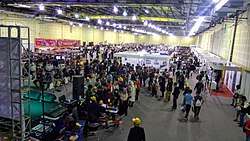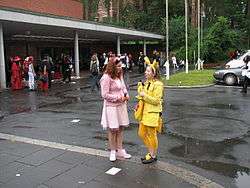Fan convention
Fan convention (also known as con or fan meeting), a term that predates 1942,[1] is an event in which fans of a particular film, television series, comic book, actor, or an entire genre of entertainment, such as science fiction or anime and manga, gather to participate and hold programs and other events, and to meet experts, famous personalities, and each other. Some also incorporate commercial activity.
Fan conventions are traditionally organized by fans on a not-for-profit basis, though some events catering to fans are run by commercial interests for profit. Many conventions have award presentations relating to their genre (such as the Hugo Awards which have been presented at The World Science Fiction Convention (WorldCon) since 1953).
At commercial events, performers often give out autographs to the fans, sometimes in exchange for a flat appearance fee, and sometimes may perform songs that have no relevance to the shows or otherwise entertain the fans. Commercial conventions are usually quite expensive and are hosted in hotels. There is often tight security for the celebrities to protect against potentially fanatic fans. Such features are not common at traditional science-fiction conventions, which are more oriented toward science fiction as a mode of literature, rather than toward visual media, and do not include any paid appearances by famous personalities, and maintain a less caste-like differentiation between professional and fan.
Anime conventions, gaming conventions, filk-music conventions, and furry conventions may all be considered derivatives of science-fiction conventions, which began in the late 1930s.


While the wearing of costumes—and even a costume competition (known in the United States as "cosplay")—has been an occasional feature of traditional science-fiction conventions since Forrest J Ackerman wore one during the First World Science Fiction Convention in 1939, this has never been the dominant feature of such events. From press coverage of comic book and anime conventions has arisen the widespread image of fans' tendency to dress up as their favorite characters in elaborate costumes (known as cosplay in anime terminology) that are time-consuming and/or expensive to assemble.
Different conventions use different methods to count their attendance, thus leading to a confusion of actual convention size.[2]
History
Fan conventions for various genres of entertainment extend to the first conventions held in the 1930s. However, while a few conventions were created in various parts of the world within the period between 1935-1960, the number of convention establishments increased slightly in the 1960s and then increased dramatically in the 1970s, with many of the largest conventions in the modern era being established during the latter decade. Impeti for further establishment of local fan conventions include:
- The return of superhero characters and franchises during the Silver Age of Comic Books (1956-1970).
- Science fiction adaptations for television serials (e.g., Star Trek) in the 1960s-1970s.
- The growth of role-playing (in the 1970s and 1980s) as a genre of tabletop, live-action and eventually video/computer gaming, which not only inspired roleplay of favorite characters in full-body costumes but also inspired existing franchises to adapt their themes for said methods of gaming.
- The growth in home taping (starting with VHS in the late 1970s) of television broadcasts, including popular serials.
- The growth of computerized communication, including the Internet and Internet-dependent applications in the 1980s and 1990s.
See also
- Science fiction fandom
- Fantasy fandom
- List of fan conventions by date of founding
- List of anime conventions
- List of comic book conventions
- List of furry conventions
- List of gaming conventions
- List of multi-genre conventions
- List of professional wrestling conventions
- List of science-fiction conventions
- Piposh, a franchise that was revived due to its fans carrying its legacy through fan conventions.
References
- Coppa, Francesca (2006), "A Brief History of Media Fandom", in Hellekson, Karen; Busse, Kristina (eds.), Fan Fiction and Fan Communities in the Age of the Internet, Jefferson, North Carolina: McFarland & Company, p. 43, ISBN 978-0-7864-2640-9
- Whitehouse, Kendall (16 October 2017). "Comic Con Attendance: Numbers, Numbers, and Numbers". ontechnologyandmedia.com. Retrieved 16 July 2018.

